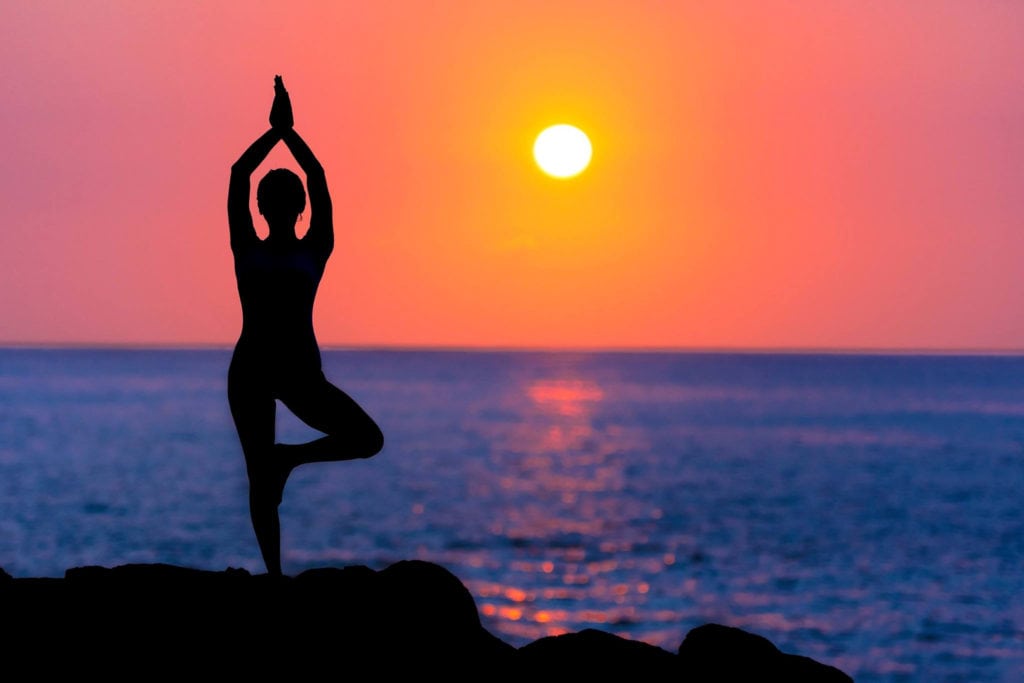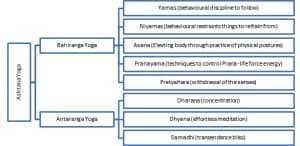Eight limbs of Patanjali’s Asthana Yoga

Patanjali’s Asthana Yoga eight Limbs
Yamaniyamāsanaprāṇāyāmapratyāhāradhāraṇādhyānasamādhayo’ṣṭāvaṅgāni||29||
Yama (yama), Niyama (niyama), Āsana (āsana), Prāṇāyāma (prāṇāyāma), Pratyāhāra (pratyāhāra), Dhāraṇā (dhāraṇā), Dhyāna (dhyāna) (and)Samādhi –samādhi– (samādhayaḥ) (are) the eight (aṣṭau) limbs –aṅga– (of Yoga) (aṅgāni)
Patanjali’s ‘Yoga Sutra’ is a systematic guide for a person who has committed to and reached a qualified state in pursuit of higher objectives of life. These sutras provide a very clear and practical approach to passing through various stages in the evolution of human consciousness with the ultimate goal of Samadhi (Merger with supreme consciousness).
Ashtanga Yoga or the eight limbs of Yoga addresses the refinement of both external (body and actions) and internal aspects (mind and consciousness) with the goal of absolute control over senses and mind and merging the consciousness with supreme Brahman. Mastery over each stage lays the foundation for the next stage.

The eight limbs of Yoga are Yama, Niyama, Asana, Pranayama, Pratyahara, Dharana, Dhyana, and Samadhi. The first three states are called Bahiranga (external) yoga and the last five stages are called as Antaranga (internal) Yoga, as they primarily deal with mind and consciousness.
- Yama: First Limb refers to the disciplines; prescribes Don’ts – the social mode of conduct. It helps to harmonize our conduct, action, and interactions in society or the external world. It sets the ethical standards and sense of integrity, focusing on our behavior and how we moral conduct. Following these Yamas one can reach a better state of Annamaya and Mamomaya kosha.
- Ahimsa: nonviolence
- Satya: truthfulness
- Asteya: nonstealing
- Brahmacharya: continence
- Aparigraha: non-covetousness
- NiyamaThe Second limb. guides the personal mode of conduct, self-discipline, and spiritual observances aimed to exercise control over senses and mind. Following these niyamas, one can attain a better state of Annamaya and Mamomaya kosha.
- Saucha: cleanliness
- Santosha: contentment
- Tapas: heat; spiritual austerities
- Svadhyaya: the study of the sacred scriptures and one’s self
- Isvara pranidhana: surrender to God
- Asanaor yogic poses are daily practices for keeping bodily discipline and for maintaining optimum health and flexibility. This prepared the body to be strong, stable, and agile for higher practices. An overall healthy body leads to a healthy mind. Following these Asanas helps to strengthen three states of Annamaya, Mamomaya, and pranamayakosha. This is the last stage of Bharanga yoga.
- Pranayamais the first fourth stage overall, and the first stage of Antaranga Yoga. It’s the gateway to higher echelons of yoga. It first focuses on the complex art and science of flow of breath (Prana or Yayu) in our body and its connection to mind and higher energy states. In simple words, it leads to gain mastery over the Prana (flow of vital breath through Nadis – not just respiratory process) as well as establishing the connection between the Prana, Chakra, mind, and energy. This offers the first glimpse or smell to the higher states of consciousness. Pranayama aims to strengthen both Pranamaya kosha has equal benefits at Mamomaya koha as well.
- Pratyahara(second state of Antarange Yoga), Pratyahara is derived from two Sanskrit words: prati and ahara, with ahara meaning food, or anything taken into ourselves, and prati, a preposition meaning away or against. It refers to withdrawal from sensory indulgence. At this stage one makes the steadfast and conscious effort to withdraw sensory and worldly temptations. This is not a forceful withdrawal but involves the absolute effortless withdrawal of senses while being fully aware. Once the senses are withdrawn from the external world, it sets the process of internalization of the mind. Pratyahara aims to control the mind and creates enormous power at Mamomaya koha.
- Dharanadeals with the concentration of the mind on an internal object. It is the beginning state of all internal visualization techniques. This stage deals with the training and control over the mind (Mamomaya kosha). Here we practice concentrating on a single object such as images, sound or touch, energy center, or a deity, or the mantra. The power of the mind to focus steadily on a pointed object leads to an inward journey away from the world.
- Dhyanaor meditation follows Dharana. While Dharna involved focus, Dyana is effortless focusing. When the mind gets effortlessly absorbed in the object of meditation for a prolonged period, it becomes Dhyana.
- Samadhior the superconscious state is when the practitioner goes beyond the sense of individuality, merging of an object, the observer, and the act of observation, through the process of meditation and eventually experiences the Brahman (Cosmic Consciousness). This is the blissful state of Anamayakosha and is described as ‘Satchitananda ( state of absolute truth-consciousness-bliss).
Yoga is a cosmic science, a scientific method to explore the universe within a human being. A practice, a process to seek answers to questions such as ‘Who am I?’. Yoga is the ultimate solution to the understanding of everything from quantum physics to cosmic consciousness.
